 F.B.MAGPIE
HOME PAGE
Seeking Butterflies
F.B.MAGPIE
HOME PAGE
Seeking Butterflies
By Wayne Hsu (taken from GATEPOST, May
1997)
 In
the early days, Taiwan used to be known as the "Kingdom of Butterflies"
because of the massive export of butterfly products. The butterflies today,
however, demand another form of attention. "Butterfly-watching" is a recently
developed activity and, like bird watching, butterfly watching is growing
in popularity. Most people ask, how do you tell butterflies from moths?
An easy and accurate method is to look at their antennas; the antennas
of all butterflies are club-shaped while moths have either pointed or feathered
antennas. It is not hard to notice some butterflies, even in the middle
of downtown Taipei, but just where do you look to see more of the 400 species
of butterflies Taiwan boasts? Actually, any place not thoroughly developed
will be a good place to start, such as many forested hills around Taipei.
Butterflies are most numerous during the warmer months, especially early
summer. Butterflies are most active in fair weather around mid-morning
and late afternoon. Some butterflies, however, are active year-round and
all day; so the more observant you are, the more butterflies you will see.
Below are some clues a butterfly watcher should take notice of when seeking
the presence of the beautiful butterflies.
In
the early days, Taiwan used to be known as the "Kingdom of Butterflies"
because of the massive export of butterfly products. The butterflies today,
however, demand another form of attention. "Butterfly-watching" is a recently
developed activity and, like bird watching, butterfly watching is growing
in popularity. Most people ask, how do you tell butterflies from moths?
An easy and accurate method is to look at their antennas; the antennas
of all butterflies are club-shaped while moths have either pointed or feathered
antennas. It is not hard to notice some butterflies, even in the middle
of downtown Taipei, but just where do you look to see more of the 400 species
of butterflies Taiwan boasts? Actually, any place not thoroughly developed
will be a good place to start, such as many forested hills around Taipei.
Butterflies are most numerous during the warmer months, especially early
summer. Butterflies are most active in fair weather around mid-morning
and late afternoon. Some butterflies, however, are active year-round and
all day; so the more observant you are, the more butterflies you will see.
Below are some clues a butterfly watcher should take notice of when seeking
the presence of the beautiful butterflies.
WHERE TO FIND
BUTTERFLIES
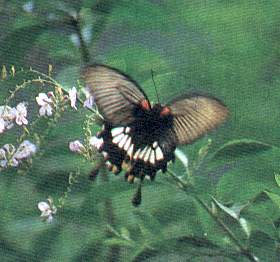
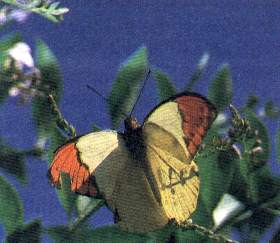 Flowers
Flowers
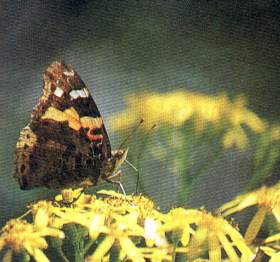 A
majority of butterflies visit flowers regularly although there are also
many butterflies that never go near flowers. Of those that do, many species
are large and attractive such as the Great Mormon (Papilio memnon),
the Great Orange Tip (Hebomoia glaucippe) or handsome Indian
Red Admiral (Venessa indica). They are easy to find, as they
like many kinds of wild or cultivated flowers; look for them in parks,
gardens, or anywhere else where a lot of flowers are blooming.
A
majority of butterflies visit flowers regularly although there are also
many butterflies that never go near flowers. Of those that do, many species
are large and attractive such as the Great Mormon (Papilio memnon),
the Great Orange Tip (Hebomoia glaucippe) or handsome Indian
Red Admiral (Venessa indica). They are easy to find, as they
like many kinds of wild or cultivated flowers; look for them in parks,
gardens, or anywhere else where a lot of flowers are blooming.
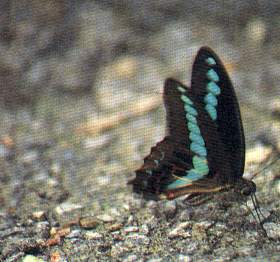 Along
the Bank of Streams or Moist Ground
Along
the Bank of Streams or Moist Ground
 Butterflies
require minerals not found in a diet of pollen, so they often drink the
water from stream beds, waterfalls, dripping faucets, or leaky pipes. They
release the water again soon after drinking it, absorbing the minerals
in the process. A wide variety of butterflies gather at damp surfaces,
especially swallowtails such as the Common Bluebottle (Graphium
sarpedon) or the endemic Papilio hoppo, but usually,
only the male butterflies drink. If urine is present in the water, it will
attract even more butterflies!
Butterflies
require minerals not found in a diet of pollen, so they often drink the
water from stream beds, waterfalls, dripping faucets, or leaky pipes. They
release the water again soon after drinking it, absorbing the minerals
in the process. A wide variety of butterflies gather at damp surfaces,
especially swallowtails such as the Common Bluebottle (Graphium
sarpedon) or the endemic Papilio hoppo, but usually,
only the male butterflies drink. If urine is present in the water, it will
attract even more butterflies!
 Citrus
Orchards
Citrus
Orchards
 To
find butterflies in an orchard, make sure it has not been sprayed. Citrus
trees often have sap leaking out of their trunks, which is a favorite diet
of many butterflies, such as this striking Dichorragia nesimachus.
Do not be surprised that many of the butterflies are well camouflaged,
such as this Blue Admiral (Kaniska canace). The larvae of
many kinds of swallowtails eat leaves of citrus trees, so swallowtail butterflies
also gather in citrus orchards to find mates and to lay eggs.
To
find butterflies in an orchard, make sure it has not been sprayed. Citrus
trees often have sap leaking out of their trunks, which is a favorite diet
of many butterflies, such as this striking Dichorragia nesimachus.
Do not be surprised that many of the butterflies are well camouflaged,
such as this Blue Admiral (Kaniska canace). The larvae of
many kinds of swallowtails eat leaves of citrus trees, so swallowtail butterflies
also gather in citrus orchards to find mates and to lay eggs.
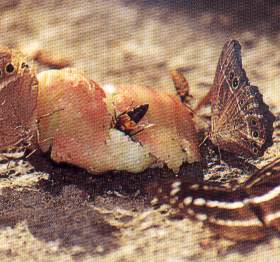 Rotting
Fruit
Rotting
Fruit
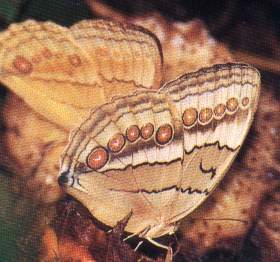 Rotting
fruit stinks, and the smell calls the attention of butterflies from long
distances away. A lot of butterflies that like tree sap also like rotting
fruit. Many of them, like these, are also well camouflaged, but not this
magnificent pair of Stichophthalma howqua. A handful of rare
species may also be lured out of hiding using rotting fruit.
Rotting
fruit stinks, and the smell calls the attention of butterflies from long
distances away. A lot of butterflies that like tree sap also like rotting
fruit. Many of them, like these, are also well camouflaged, but not this
magnificent pair of Stichophthalma howqua. A handful of rare
species may also be lured out of hiding using rotting fruit.
Animal Droppings
Another stinking favorite of some butterflies--and flies too--is animal
dung! The dung humans or animals leave behind often attracts butterflies
once they pick up its "aroma." However, most of the butterflies here, such
as this 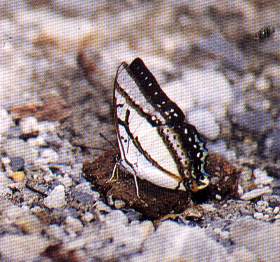 Great
Nawab (Polyura eudamippus), would also be glad to visit orchards
and rotting fruit, where it may be more pleasant for the observer!
Great
Nawab (Polyura eudamippus), would also be glad to visit orchards
and rotting fruit, where it may be more pleasant for the observer!
RAISING BUTTERFLIES
Raising butterflies is often thrilling for children and adults alike.
Simple research will tell you the food plant of a butterfly's larvae. The
next time you go outdoors, examine the undersides of the leaves of the
food plant.  With
luck, you may find some eggs or larvae. Carefully pluck the leaf with the
egg or larvae on it and keep it in a closed container. Clean out the container
and feed the larvae fresh leaves from the food plant every day. When the
larvae matures, it will become a motionless pupa on the side of the container.
Now, all you have to do is wait.
With
luck, you may find some eggs or larvae. Carefully pluck the leaf with the
egg or larvae on it and keep it in a closed container. Clean out the container
and feed the larvae fresh leaves from the food plant every day. When the
larvae matures, it will become a motionless pupa on the side of the container.
Now, all you have to do is wait. 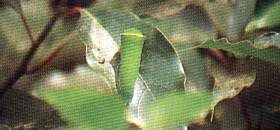 The
rewarding experience of seeing your own butterfly emerge from its pupa
shell and spread out its gorgeous wings cannot be described with words.
After witnessing the struggles a caterpillar must overcome before finally
developing into an awe-inspiring creature, people will only feel deep respect
for these wonderful creatures.
The
rewarding experience of seeing your own butterfly emerge from its pupa
shell and spread out its gorgeous wings cannot be described with words.
After witnessing the struggles a caterpillar must overcome before finally
developing into an awe-inspiring creature, people will only feel deep respect
for these wonderful creatures.
[ Trip
Reports | Photo Gallery | Art
Gallery | Bird Calls | Birds
of TAS | Links | Webrings
| Guestbook
| ICQ ]


 Along
the Bank of Streams or Moist Ground
Along
the Bank of Streams or Moist Ground
 Butterflies
require minerals not found in a diet of pollen, so they often drink the
water from stream beds, waterfalls, dripping faucets, or leaky pipes. They
release the water again soon after drinking it, absorbing the minerals
in the process. A wide variety of butterflies gather at damp surfaces,
especially swallowtails such as the Common Bluebottle (Graphium
sarpedon) or the endemic Papilio hoppo, but usually,
only the male butterflies drink. If urine is present in the water, it will
attract even more butterflies!
Butterflies
require minerals not found in a diet of pollen, so they often drink the
water from stream beds, waterfalls, dripping faucets, or leaky pipes. They
release the water again soon after drinking it, absorbing the minerals
in the process. A wide variety of butterflies gather at damp surfaces,
especially swallowtails such as the Common Bluebottle (Graphium
sarpedon) or the endemic Papilio hoppo, but usually,
only the male butterflies drink. If urine is present in the water, it will
attract even more butterflies!
 F.B.MAGPIE
HOME PAGE
F.B.MAGPIE
HOME PAGE
 In
the early days, Taiwan used to be known as the "Kingdom of Butterflies"
because of the massive export of butterfly products. The butterflies today,
however, demand another form of attention. "Butterfly-watching" is a recently
developed activity and, like bird watching, butterfly watching is growing
in popularity. Most people ask, how do you tell butterflies from moths?
An easy and accurate method is to look at their antennas; the antennas
of all butterflies are club-shaped while moths have either pointed or feathered
antennas. It is not hard to notice some butterflies, even in the middle
of downtown Taipei, but just where do you look to see more of the 400 species
of butterflies Taiwan boasts? Actually, any place not thoroughly developed
will be a good place to start, such as many forested hills around Taipei.
Butterflies are most numerous during the warmer months, especially early
summer. Butterflies are most active in fair weather around mid-morning
and late afternoon. Some butterflies, however, are active year-round and
all day; so the more observant you are, the more butterflies you will see.
Below are some clues a butterfly watcher should take notice of when seeking
the presence of the beautiful butterflies.
In
the early days, Taiwan used to be known as the "Kingdom of Butterflies"
because of the massive export of butterfly products. The butterflies today,
however, demand another form of attention. "Butterfly-watching" is a recently
developed activity and, like bird watching, butterfly watching is growing
in popularity. Most people ask, how do you tell butterflies from moths?
An easy and accurate method is to look at their antennas; the antennas
of all butterflies are club-shaped while moths have either pointed or feathered
antennas. It is not hard to notice some butterflies, even in the middle
of downtown Taipei, but just where do you look to see more of the 400 species
of butterflies Taiwan boasts? Actually, any place not thoroughly developed
will be a good place to start, such as many forested hills around Taipei.
Butterflies are most numerous during the warmer months, especially early
summer. Butterflies are most active in fair weather around mid-morning
and late afternoon. Some butterflies, however, are active year-round and
all day; so the more observant you are, the more butterflies you will see.
Below are some clues a butterfly watcher should take notice of when seeking
the presence of the beautiful butterflies.

 Flowers
Flowers
 A
majority of butterflies visit flowers regularly although there are also
many butterflies that never go near flowers. Of those that do, many species
are large and attractive such as the Great Mormon (Papilio memnon),
the Great Orange Tip (Hebomoia glaucippe) or handsome Indian
Red Admiral (Venessa indica). They are easy to find, as they
like many kinds of wild or cultivated flowers; look for them in parks,
gardens, or anywhere else where a lot of flowers are blooming.
A
majority of butterflies visit flowers regularly although there are also
many butterflies that never go near flowers. Of those that do, many species
are large and attractive such as the Great Mormon (Papilio memnon),
the Great Orange Tip (Hebomoia glaucippe) or handsome Indian
Red Admiral (Venessa indica). They are easy to find, as they
like many kinds of wild or cultivated flowers; look for them in parks,
gardens, or anywhere else where a lot of flowers are blooming.
 Citrus
Orchards
Citrus
Orchards
 To
find butterflies in an orchard, make sure it has not been sprayed. Citrus
trees often have sap leaking out of their trunks, which is a favorite diet
of many butterflies, such as this striking Dichorragia nesimachus.
Do not be surprised that many of the butterflies are well camouflaged,
such as this Blue Admiral (Kaniska canace). The larvae of
many kinds of swallowtails eat leaves of citrus trees, so swallowtail butterflies
also gather in citrus orchards to find mates and to lay eggs.
To
find butterflies in an orchard, make sure it has not been sprayed. Citrus
trees often have sap leaking out of their trunks, which is a favorite diet
of many butterflies, such as this striking Dichorragia nesimachus.
Do not be surprised that many of the butterflies are well camouflaged,
such as this Blue Admiral (Kaniska canace). The larvae of
many kinds of swallowtails eat leaves of citrus trees, so swallowtail butterflies
also gather in citrus orchards to find mates and to lay eggs.
 Rotting
Fruit
Rotting
Fruit
 Rotting
fruit stinks, and the smell calls the attention of butterflies from long
distances away. A lot of butterflies that like tree sap also like rotting
fruit. Many of them, like these, are also well camouflaged, but not this
magnificent pair of Stichophthalma howqua. A handful of rare
species may also be lured out of hiding using rotting fruit.
Rotting
fruit stinks, and the smell calls the attention of butterflies from long
distances away. A lot of butterflies that like tree sap also like rotting
fruit. Many of them, like these, are also well camouflaged, but not this
magnificent pair of Stichophthalma howqua. A handful of rare
species may also be lured out of hiding using rotting fruit.
 Great
Nawab (Polyura eudamippus), would also be glad to visit orchards
and rotting fruit, where it may be more pleasant for the observer!
Great
Nawab (Polyura eudamippus), would also be glad to visit orchards
and rotting fruit, where it may be more pleasant for the observer!
 With
luck, you may find some eggs or larvae. Carefully pluck the leaf with the
egg or larvae on it and keep it in a closed container. Clean out the container
and feed the larvae fresh leaves from the food plant every day. When the
larvae matures, it will become a motionless pupa on the side of the container.
Now, all you have to do is wait.
With
luck, you may find some eggs or larvae. Carefully pluck the leaf with the
egg or larvae on it and keep it in a closed container. Clean out the container
and feed the larvae fresh leaves from the food plant every day. When the
larvae matures, it will become a motionless pupa on the side of the container.
Now, all you have to do is wait.  The
rewarding experience of seeing your own butterfly emerge from its pupa
shell and spread out its gorgeous wings cannot be described with words.
After witnessing the struggles a caterpillar must overcome before finally
developing into an awe-inspiring creature, people will only feel deep respect
for these wonderful creatures.
The
rewarding experience of seeing your own butterfly emerge from its pupa
shell and spread out its gorgeous wings cannot be described with words.
After witnessing the struggles a caterpillar must overcome before finally
developing into an awe-inspiring creature, people will only feel deep respect
for these wonderful creatures.